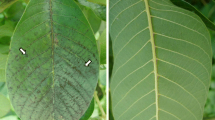Abstract
The development of sclerotia of Claviceps purpurea was investigated by light and electron microscopy. During the first days after infection sterigma and conidiospores are formed. The spores show a moderately developed vacuolar system, they are thick walled and contain about 20% lipid (related to the cell volume) embedded in glycogen. The sterigma are cylindrical unicellular hyphae with electron dense cytoplasm and isolated strongly contrasted lipid droplets. In maturing sclerotia the hyphae become septated with increasingly thick cell walls and a large lipid content. The lipid forms small droplets in young cells, while in the mature sclerotium it occurs in the form of very large drops, occupying the major part of the cell. Simultaneously the composition of the lipid is changed. The mature cells have several nuclei. They are partially connected by osmiophilic substances, forming a network of intercellular spaces.
Similar content being viewed by others
Abbreviations
- HEPES:
-
N-2-hydroxyethylpiperazine-N'-2-ethanesulfonic acid
- DMSO:
-
Dimethylsulfoxide
References
Bergfeld, R., Hong, Y.-N., Kühnl, T., Schopfer, P.: Formation of oleosomes during embryogenesis and their breakdown during seedling development in cotyledons of Sinapis alba I. Planta 143, 297–307 (1978)
Böhm, K. J., Unger, E.: Demonstration of crystalline structures in protoplasts of S. corlsbergensis prepared by cryoultramicrotomy. Cytobiol. 15, 159–168 (1977)
Carrol, G. C., Carrol, F. E.: The fine structure of conidium development in Phialocephala dimorphosphora. Can. J. Bot. 52, 2119–2128 (1974)
De Bary, A.: Vergleichende Morphologie und Biologie der Pilze, Mycetozoen und Bakterien. Leipzig: Verlag Wilhelm Engelmann, 1884.
Jung, M., Rochelmeyer, H.: Zur Morphologie und Zytologie von Claviceps purpurea (Tulasne) in saprophytischer Kultur. Beitr. Biol. Pflanzen 35, 373–378 (1959)
Komersová, I., Ludvík, J., Majer, J.: The ultrastructure of spores of Claviceps purpurea (Fr.) Tul. Fol. Microbiol. 14, 141–144 (1969)
Kybal, J.: Neue Beobachtungen über die Bildung der Sklerotien von Claviceps purpurea (Fr.) Tul. Planta medica 12, 166–168 (1964)
Langeron, M.: Précis de mycologie. Paris: Masson 1945
Mantle, P. G., Tonolo, A.: Relationship between the morphology of Claviceps purpurea and the production of alkaloids. Trans. Brit. mycol. Soc. 51, 499–506 (1968)
Mantle, P. G., Morris, L. J., Hall, S. W.: Fatty acid composition of sphacelial and sclerotial growth forms of Claviceps purpurea in relation to the production of ergoline alkaloids in culture. Trans. Brit. mycol. Soc. 53, 441–447 (1969)
Matile, Ph., Wiemken, A., Moor, H.: Vacuolar dynamics in synchronously yeast. Arch. Microbiol. 70, 89–103 (1970)
Milovidov, P.: Beitrag zum mikroskopisch-morphologischen Studium der Mutterkornentwicklung (Claviceps purpurea). Preslia 26, 415–426 (1954)
Milovidov, P.: Nuklearfärbung der Zellkerne von verschiedenen Entwicklungsstadien des Mutterkornpilzes (Claviceps purpurea/Tul.). Acta histochem. 4, 41–46 (1957)
Moor, H.: Endoplasmic reticulum as the initiator of the bud formation in yeast (S. cerevisiae). Arch. Microbiol. 57, 135–146 (1967)
Neumann, D., Lösecke, W., Meier, W., Gröger, D.: Localization of alkaloids in sclerotia and suspension cultures of Claviceps purpurea (Fr.) Tul. Biochem. Physiol. Pflanzen 174, 504–508 (1979)
Řeháček, Z., Malik, K. A.: Physiological status of submerged Claviceps during enzymatic assembly of ergot alkaloids. Fol. Microbiol. 17, 490–499 (1972)
Reynolds, E. S.: The use of lead citrate at high pH as an electronopaque stain in electron microscopy. J. Cell Biol. 17, 208–212 (1963)
Schwarzenbach, A. M.: Observations on spherosomal membranes. Cytobiol. 4, 145–147 (1971)
Silber, A., Bischoff, W.: Die Konstanz des Alkaloidgehaltes bei verschiedenen Rassen von Mutterkorn. Pharmazie 9, 46–61 (1954)
Streiblová, E., Rýc, M., Kybal, J.: Fine structure of imbibed sclerotial cells of Claviceps purpurea (Fr.) Tul. revealed by freezeetching. Z. allg. microbiol. 18, 124–134 (1978)
Tulasne, L. R.: Mémoire sur l'ergot des glumacées. Ann. Sci. Nat. III 20, 5–56 (1853)
Wiemken, A.: Eigenschaften der Hefevakuole. Thesis No. 4340, ETH Zürich 1969
Author information
Authors and Affiliations
Rights and permissions
About this article
Cite this article
Lösecke, W., Neumann, D., Gröger, D. et al. Changes of the cytoplasmic ultrastructure during development of sclerotia in Claviceps purpurea (Fr.) Tul.. Arch. Microbiol. 125, 251–257 (1980). https://doi.org/10.1007/BF00446885
Received:
Issue Date:
DOI: https://doi.org/10.1007/BF00446885




